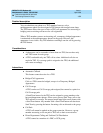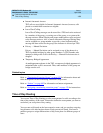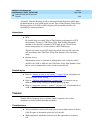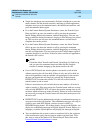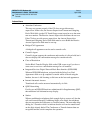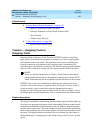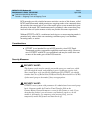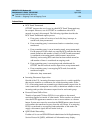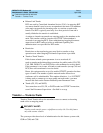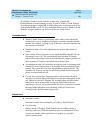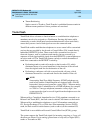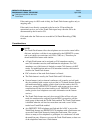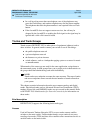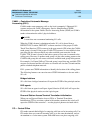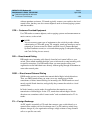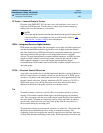
DEFINITY ECS Release 8.2
Administrator’s Guide
555-233-506
Issue 1
April 2000
Features and technical reference
1560Transfer — Trunk-to-Trunk
20
■ Release Link Trunks
RLTs are used by Centralized Attendant Service (CAS). An outgoing RLT
at a remote branch is used to access an attendant at the main. The attendant
at the main can transfer the incoming caller to a station or trunk at the
branch. The RLT is typically used only for a short period of time and is
usually idled after the transfer is established.
A station at a branch can transfer an outgoing trunk to the attendant at the
main. This transfer could be viewed as an OTTOTT (the attendant is
accessed via an outgoing RLT). Since administering outgoing disconnect
supervision for RLT trunks provides no additional capability, this
administration is not provided for RLT trunks.
■ Restriction
Restrictions on the transferring party may block a transfer or drop
operation even when Outgoing Disconnect Supervision is provided.
■ Trunk-to-Trunk Transfer
If this feature-related system parameter is set to restricted, all
trunk-to-trunk transfer/release/drop operations for public trunks (CO, CPE,
CAS, DID, DIOD, FX, and WATS) have calls terminated or receive denial.
If the parameter is set to none, all trunk-to-trunk transfers (except CAS and
DCS) have calls terminated or receive denial.
Hence, this option must be set to all to enable OTTOTT operation for these
types of trunks. The number of public-network trunks allowed on a
conference call is administrable. This number defaults to 1, so if OTTOTT
is being used to connect two or more public network trunks, you must
increase this limit on the Feature-Related System Parameters form.
■ Trunks (CO, FX, and WATS)
You cannot have two CO, FX, or WATS trunks in a OTTOTT connection,
even if the Disconnect Supervision - Out field is set to
y.
Transfer — Trunk-to-Trunk
Trunk-to-Trunk Transfer allows the attendant or user to connect an incoming
trunk call to an outgoing trunk.
!
SECURITY ALERT:
Trunk-to-trunk transfer poses a significant security risk. Use this feature
only with extreme caution.
The system provides three levels of administration for this feature: system-wide,
COR-to-COR, and COS.



